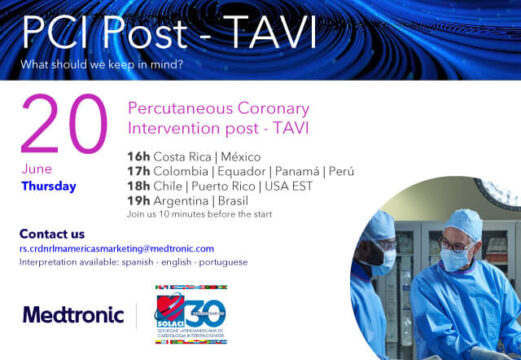A new virtual educational event organized by the Latin American Society of Interventional Cardiology with the support of Medtronic is approaching. On this occasion, we will hold a 90-minute event on Post PCI – TAVI with renowned Latin American specialists and the presence of Dr. Gilbert Tang (USA). Consult the scientific agenda and register. The…
Temporal Trends in Transcatheter Aortic Valve Replacement for Isolated Severe Aortic Stenosis
A study by the Northern New England Cardiovascular Disease Group Consortium recently published online identified all patients with aortic valve stenosis treated with surgical or transcatheter aortic valve replacement between 2016 and 2022 in Maine, New Hampshire, and Vermont (USA). These patients were divided for analysis into three age groups: under 65 years old, 65…
NOTION Trial: 10 Year Outcomes, TAVR vs. SAVR in Low Risk Patients
Transcatheter aortic valve replacement (TAVR) has revolutionized the treatment of patients with severe aortic stenosis (AS). Randomized studies have shown the benefits of TAVR for treating inoperable patients, as well as high and intermediate risk patients. The NOTION (Nordic Aortic Valve Intervention Trial) randomized patients with low risk severe AS to TAVR or SAVR (surgical…
Guidewire Pacing and Pressure Assessment in TAVR: The SAFE-TAVI Study
Currently, the number of transcatheter aortic valve replacement (TAVR) procedures is increasing as it expands towards a lower-risk younger population. Therefore, continuous technological advancement is imperative to reduce post-procedural complications. The Food and Drug Administration (FDA) has approved the SavyWire, a preformed 0.035-gauge guidewire that can perform three essential functions: 1) it facilitates prosthesis transportation…
SAFE-TAVI Study: Safety and Efficacy of the Pressure Sensor and Pacing Guidewire
Currently, we observe an increase in the number of transcatheter aortic valve replacement (TAVR) procedures due to its expansion toward a younger population with lower risk. For this reason, it is crucial to maintain continuous technological innovation to minimize post-procedural complications. The FDA has approved the SavyWire, a preformed 0.035-caliber guidewire that offers three essential…
TCT 2023 | EVOLUT Low Risk: 4-Year Follow-up
In recent years, there has been a steady increase in the use of transcatheter aortic valve replacement (TAVR) in younger patients, with an average age of 74 years, as observed in US medical records. This trend goes alongside encouraging durability results, as demonstrated in the 10-year NOTION study, where structural valve degeneration (SVD) with first-generation…
TCT 2023 | The WATCH-TAVR Study
In the TVT registry, around 40% of the patients eligible for transcatheter aortic valve replacement (TAVR) had atrial fibrillation, and there were high levels of adverse events after starting anticoagulant treatment, especially with oral anticoagulants (VKAs), primarily due to bleeding. The purpose of this study was to assess the feasibility, safety, and efficacy of combined…
Cause of Cardiac Death after TAVR at Present
Cardiac failure (CF) and sudden cardiac death (SCD) stand out as two of the main causes of death in patients with aortic stenosis. Although transcatheter aortic valve intervention has shown higher survival, these two continue to be the main conditions leading to patient death at followup. In its early days, TAVR also showed benefits, but…
TAVR Durability at 5 Years in Intermediate Risk Patients
TAVR has been shown beneficial in patients across the risk spectrum. The PARTNER 2 SAPIEN 3 (P2S3i) study on intermediate risk patients was the first to show TAVR superiority vs SAVR when using the transfemoral approach. SAVR durability has been shown in different analysis but, except for a few reports, TAVR durability at long term…
Aortic Stenosis and Cardiogenic Shock: Is TAVR an Option?
Cardiogenic shock (CS) in a setting of aortic stenosis is associated with high mortality rates. In consequence, surgery is generally not a possibility for this patient group, and they usually undergo aortic valvuloplasty, resulting in a mortality rate of 33%-50% at 30 days, 70% at one year, and 90% at two years. While transcatheter aortic…







